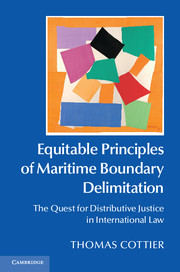 Equitable Principles of Maritime Boundary Delimitation
Equitable Principles of Maritime Boundary Delimitation Book contents
- Frontmatter
- Dedication
- Contents
- List of tables
- List of maps
- Preface
- Acknowledgements
- Table of cases
- Table of treaties and instruments
- Equity revisited: an introduction
- PART I Context: the enclosure of the seas
- 1 The silent revolution
- 2 The new maritime zones: evolution and legal foundations
- 3 Distributive effects of the enclosure movement: an assessment of global equity
- PART II The new boundaries
- PART III Delimitation based on equity
- Appendix I Maritime boundary agreements 1942–1992
- Appendix II General maps
- Bibliography
- Index
2 - The new maritime zones: evolution and legal foundations
from PART I - Context: the enclosure of the seas
Published online by Cambridge University Press: 05 May 2015
- Frontmatter
- Dedication
- Contents
- List of tables
- List of maps
- Preface
- Acknowledgements
- Table of cases
- Table of treaties and instruments
- Equity revisited: an introduction
- PART I Context: the enclosure of the seas
- 1 The silent revolution
- 2 The new maritime zones: evolution and legal foundations
- 3 Distributive effects of the enclosure movement: an assessment of global equity
- PART II The new boundaries
- PART III Delimitation based on equity
- Appendix I Maritime boundary agreements 1942–1992
- Appendix II General maps
- Bibliography
- Index
Summary
Horizontally shared zones and quasi-territoriality
Before turning to the subject of maritime boundary delimitation properly speaking and the core functions of equity, it seems appropriate to describe and analyse the scope and legal nature of the new zones of the continental shelf and the exclusive economic zone (EEZ) which the silent revolution brought about. Description, development and a legal analysis will be of importance to subsequent discussions of the boundary problem, since equitable principles and the operation of delimitation are influenced by the very foundations, the purpose and the legal nature of the two zones involved. No further discussion of the law of the Area will be provided except those aspects relating to seaward maritime boundary delimitation. The following discussion therefore excludes zones which the United Nations Convention on the Law of the Sea (LOS Convention) placed under supranational jurisdiction but which are in actual fact mainly used on the basis of mutually agreed appropriation of the resources by mining states.
Though different in many respects, the new zones of the continental shelf and the EEZ show important conceptual similarities. Unlike the territorial sea, they constitute zones of partial jurisdiction. This jurisdiction is limited to specific resources and activities. States have exclusive rights to these particular resources from the outset. As a result, these resources can no longer be understood in the traditional terms of res communis or res nullius, as being open to appropriation on the basis of free access or acquisition under effective and continuous control. At the same time, the exercise of these exclusive rights has to be reconciled with rights shared by other subjects and exercised within the same region, which requires a careful balance of interests. Since the zones are related to specific resources, they do not reflect the established territorial concepts of full sovereignty typical for terra firma.
- Type
- Chapter
- Information
- Equitable Principles of Maritime Boundary DelimitationThe Quest for Distributive Justice in International Law, pp. 67 - 129Publisher: Cambridge University PressPrint publication year: 2015


